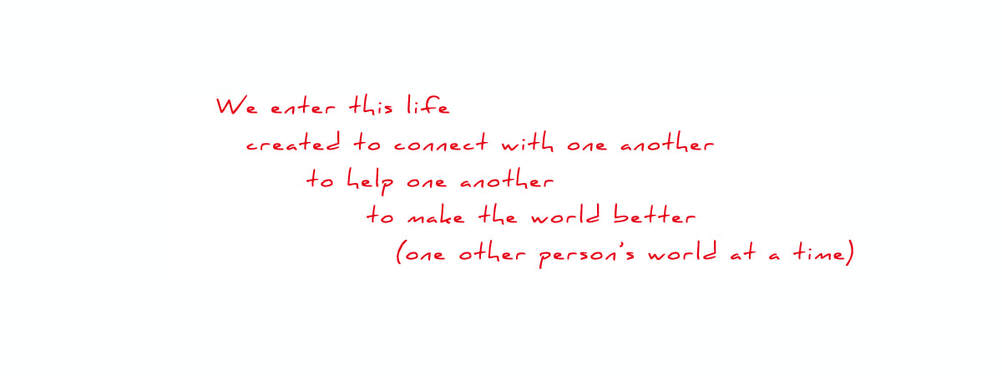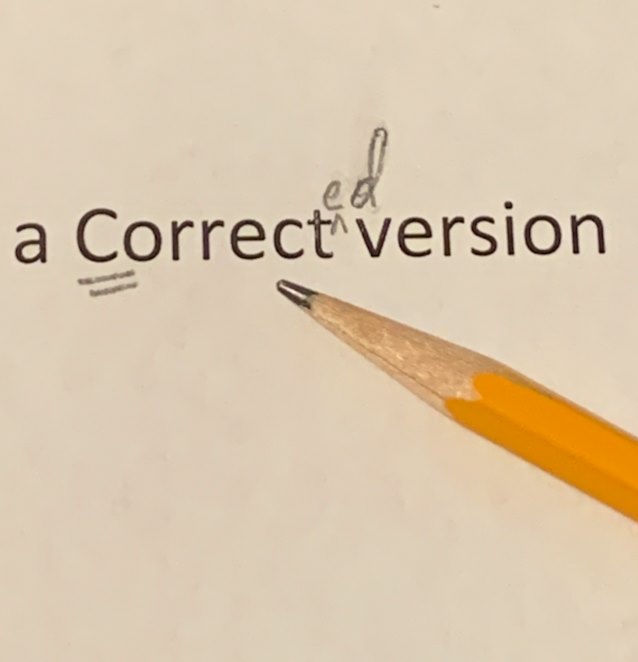|
Many want to right wrongs; few want to write wrong. In a conversation with my editor, our discussion focused on the undervalued, yet priceless role editing plays. In writing, for sure -- but also in life. Editors read an author’s words and apply expert scrutiny, a process at its best when brutal. Then a corrected version returns to the writer who now faces a choice: Make the changes or ignore them. Personal experience has proven that revisions carry immense value and, therefore, deserve strong consideration. Writers do their best work when they trust their editors to share the truth about what must improve, even when the feedback feels lousy. A similar dynamic happens whenever willingness for scrutiny exists. A board chair once shared advice to help sharpen my decision-making: “Listen closely to people who disagree with you. If no one does, invite someone in who will.” She continued: “The best decisions emerge from hearing truth, not from hearing everyone agree.” Ancient wisdom reinforces the ultimate value of who and what you believe: “…the truth will set you free.” ©Copyright 2021, David Staal, all rights reserved
0 Comments
Journeys must start somewhere. A nonprofit director faced a difficult donor conversation, unsure if the person would continue to give. She sought advice on how to handle the meeting and heard: “No matter which way it goes, say thank you. Thank you for continuing your support or Thank you for supporting us for many years.” She felt relief like a cool breeze, then dialed the phone. A thousand miles away, a man interviewed for a promotion and awaited the outcome. He felt anxious about how to handle the call and asked for suggestions. “Either way say thank you; for the new job or for the opportunity to receive consideration.” Another cool breeze blew. Saying “Thank you” shows gratitude. And gratitude is a key indicator of joy. And joy is not determined by circumstances -- if a donation happens or a job offer materializes -- or any other winds of change that blow your way. Our world needs more joy, deep joy. Does it really start by saying thank you? Yes, according to ancient wisdom: “For the mouth speaks what the heart is full of.” ©Copyright 2021, David Staal, all rights reserved
During pre-trip prep, a whitewater rafting guide shared important reminders about listening, bouncing off rocks, and paddling. He also shared priceless wisdom. “Your job is to do what I say right away,” he said. “When I yell ‘hard forward,’ then really dig in. If you hear ‘back,’ then paddle like we’re going in reverse. Anyone know why we will do that?” “Because you tell us to?” said someone attempting humor. The guide ignored the comment. “We need to control our speed. The only way to navigate is to make our raft go faster than the water or slower than the water. When we go the same speed as the current, we go wherever the river wants to take us.” Those words proved invaluable to pilot a class 5 river -- and to navigate life. Go the same speed as everyone around you, and you go wherever the crowd takes you. Prepare to hit rocks. Figure out how and when to dig in or slow down, though, and the journey turns exhilarating. Your choice. ©Copyright 2021, David Staal, all rights reserved
©Copyright 2021, David Staal, all rights reserved
Two leaders, a decade apart, shared words that 1) built my integrity as a spokesperson and 2) lowered my blood pressure.
What did they say? The first advice came while preparing for a press briefing in response to unwanted and distorted publicity. I commented that with the right spin, we could sway the media to our angle. After a quick, biting comment about that approach, I heard a better game plan: “Worry less about how things look and focus more on how things really are.” The second piece of golden counsel dealt with a much different circumstance. Less than a year into running an organization, I called our board chair to announce bad news. A dark financial report caused me to panic, which proved easy for him to discern. His response provided the calm I needed: “Situations are rarely as good as they seem or as bad as they seem.” Neither person gave me a solution. Instead, they shared something timeless and priceless -- the freedom that comes from embracing reality. Nearly a modern edition of the ancient wisdom: “Fix your thoughts on what is true, and honorable, and right, and pure, and lovely, and admirable.” ©Copyright 2021, David Staal, all rights reserved A friend purchased his dad’s graphic design studio and it’s now a premier creative agency. Our working relationship and friendship began in the analog world of brochures and, over a couple decades, has continued into the digital world where they provide innovative leadership.
Along the way, he’s remodeled their building multiple times. Unassuming from the outside, it’s a digital Disneyland inside. On a tour of the facility, he unlocked the door to a small room in the basement. As the lights turned on, so did his smile. “This,” he said, “is where I come to think and gain clarity.” Gesturing to the large layout table, graphic designer utensils, pivoting desk lamps, and backless stools, he explained that the room held the original tools of the trade his dad used in the studio’s early days. “I love this space because it reminds me of where we’ve been.” Did I mention that he owns a premier firm and has figured out how to also partner with organizations that improve the world? My friend has a humble, grounded view of true success. That brief moment breathing in his firm’s history delivered a timeless lesson; respect the past in order to inform perspective about the road ahead. So many answers for today’s challenges already exist for those willing to revisit experience -- their own or that of others. Such a simple journey could start with esteem for ancient wisdom: “For what does it profit a man to gain the world and lose his soul?” ©Copyright 2021, David Staal, all rights reserved Many years ago, I received an offer to shift roles that sounded exciting until I learned the new job meant I no longer had a large team to lead. Popular wisdom says: “If you think you’re leading, but no one is following, then you’re only taking a walk.”
Our organization’s president offered a different perspective. “This role will require you to learn how to lead by influence and what it really means to serve people. You’ll become a more effective leader because most people can only lead by authority,” he said. “Take away their position, though, and often no one will choose to follow them. That’s not leadership; it’s hierarchy.” I took the role. Fortunately, the president provided ongoing, nearly real-time mentoring; he proved surprisingly generous with his time. Years later, he made a recommendation that landed me in a CEO role at a different organization. “You’re ready,” he said. Today, he leads one of our country’s largest nonprofit organizations, and his people there love him as their leader for the right reasons. I still do, too. What a great example of better, enduring wisdom: “Whoever wants to be a leader among you must be your servant.” It’s hiring and annual review season. Experience has taught that although words enter my ears, I need not let every one of them establish residency.
22 years ago, a person agreed to approve my hire despite two reservations: 1) She said I didn’t have what it takes to serve as the organization’s voice, and 2) determined I had no writing skills. Years later, another leader decided to appoint me as local/national media spokesperson during a very turbulent PR season. A few years after that, a different leader asked me to co-author a book – the first of several published. Clearly, authority and wisdom can travel on separate itineraries. In a world overflowing with opinion, experience has shown that these words point to a better way: "Guard your heart above all else, for it determines the course of your life." Look hard at today to see a brighter tomorrow.So much has changed these days that even the word change became pivot.
Plenty of other vocabulary variations have taken place:
Let’s turn attention back to pivot. As a native of Indiana, the state crazy for basketball, pivots seem humorously simple. But for nonprofit organizations, they’re no laughing matter. For some, a pivot must happen, or the game is over. Seriously. In a basketball gym, rules allow a player with the ball to turn and face a different direction (a pivot) as long as one foot remains on the floor and does not fully lift or slide. In the nonprofit arena, let your mission and values serve as the foot that stays grounded. Swing that program, events plan, or fundraising effort as far as needed. The challenge every organization faces – determining what direction is the right way to go, and how far is enough. A daunting task indeed when considering that no one really knows what to expect in the future. Or even next week. Keep this truth in mind: Nobody knows, which means everyone offers guesses. Oh wait, I mean projections based on the latest models. However, shelter in place does not mean stand still and do nothing. Very few organizations have the option to hibernate until this harsh season changes. You owe it to the people you serve, the people you lead, and the people who fund you to figure out what change(s) to make. The starting point for any pivot: Ask the right questions. The type with hard answers that could change everything and even threaten your organization’s relevance or reason to exist. Or they might affirm it all and point toward new opportunities. Yes, go there. Every entity works within its unique realities, so you and your team must determine the specific questions that ache to be asked. What was once important, practical, or feasible might now be quite different – and will drive the need to consider changing. Some situations call for minor modifications; other circumstances require pivoting with heft. This search for the right questions to ask will only work well when you worry less about how things look and more about how things are. Perceptions often prove far too weak to lean on when challenging times arrive. Reality provides the firm footing needed. To start, let’s rummage through a pile of questions unearthed by other organizations as they dig to find their best pivots, and then ask them in your specific context. How has the constituency we serve changed? For example, if an organization serves students, then all will be fine when school opens this fall, right? Not so fast. Will school open? Will they allow visitors? What schedule will they follow? What changes will take place that may or may not accommodate your program? Organizations that serve in elementary, middle, and high school face these questions, as do those who operate on college campuses. While operational challenges mount, demand might also increase. Keep demand in mind as a story to tell with donors because great cases for funding involve pivoting changes into new opportunities. Key question: How does our program need to change for us to continue pursuing our mission? What about events? Many associations have gatherings as a core element of how they serve members. National, regional, annual, quarterly, networking, training, or any other type of in-person get-together deserves sober scrutiny. For some associations, other income streams will continue to provide funds. Others, though, face dire futures if they can’t assemble their members because events serve as the reason they exist. Even though governors will eventually relax guidelines, that’s not the same as an individual’s willingness to travel and attend. Imagine the value potential from a pivot from gather together to meet you where you’re at. Key question: What shifts should we consider to how we keep our members feeling like they belong and are being served? What about donors? Sure, the stock market will bounce back and with it preserve the investment portfolios that drive the amounts many foundations grant each year, which should preserve the total amount foundations give. However, many made early and extra gifts (to all who did: well done!) that could impact gift levels throughout the remainder of their fiscal years. What about your largest individual donors? Many own businesses, so what bounce will they experience – and when? Lower-end donations will diminish, as seen in recent survey data that shows 64 percent of churches experience decreased giving (click here to read). As the collection plate goes, so goes the small gift segment. Mid-level donors will always remain a hard-to-solve mystery, but smart money will bet on a significant decline in their giving too. However, there seems to be a collective national vibe of getting through this together and an appetite for innovative solutions. How would your donors react to a message pivot that turns remember that we need you into a new story to tell? Key questions: By segment, what can we anticipate from our donors and what should we proactively do as a result? What’s our fresh approach and our new story to tell? What will happen with public funding? Government grants seem generous now, but will money continue to flow to NGOs once the urgency around COVID-19 diminishes? What will the government’s posture look like toward the social services sector whose clients’ needs multiply due to the economic crisis that promises to linger? How reliable will national, state, or local government funding become going forward, especially when tax revenues fall and direct assistance bills mount? When government funding falls short, competition increases for support. But now is a tough time to consider ramping up infrastructure. Has the time come to pivot from react on our own to collaborate? Key question: What options exist to navigate drops in public support, and how might we re-position to avoid such decreases? Pivots and changes have become so common that they will, without doubt, play featured roles in the much-anticipated new normal. Ask the right questions and you’ll be part of it too. © 2020 David Staal. All rights reserved. davidstaal.net |
AuthorDavid Staal writes, speaks, consults, and has filled a career with executive and leadership positions Blogs/Articles |













 RSS Feed
RSS Feed